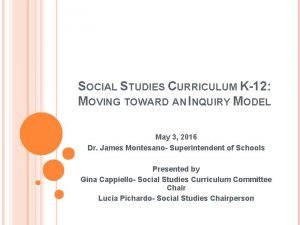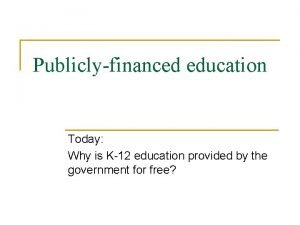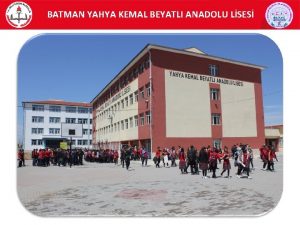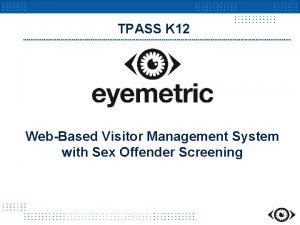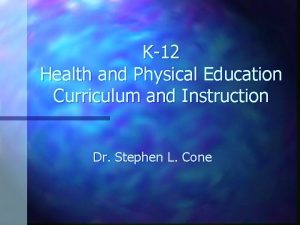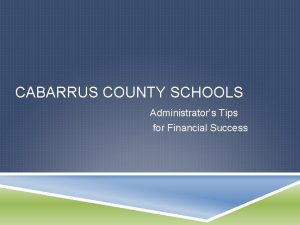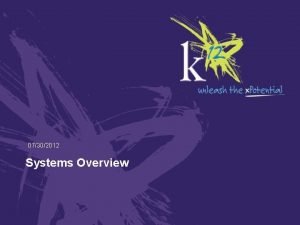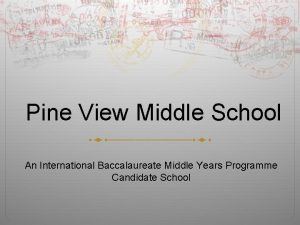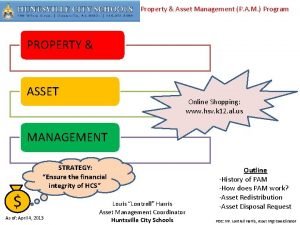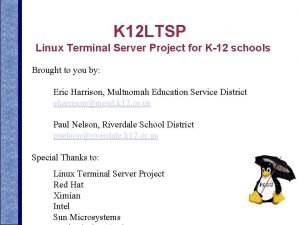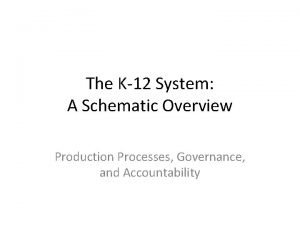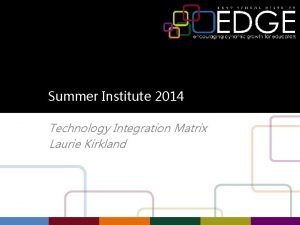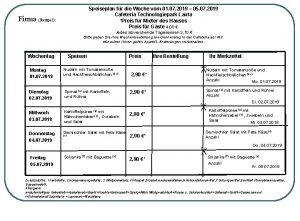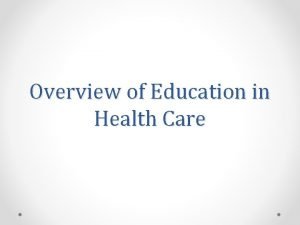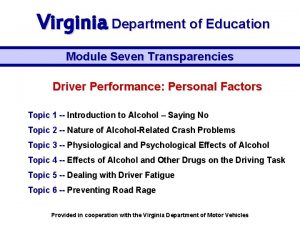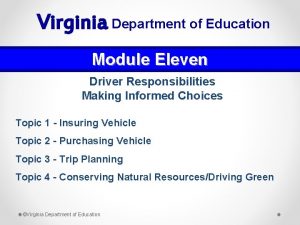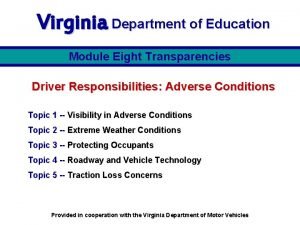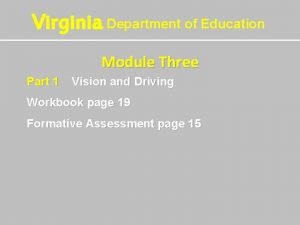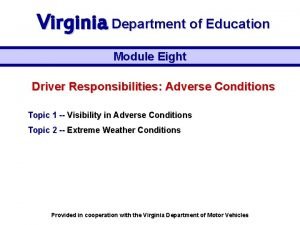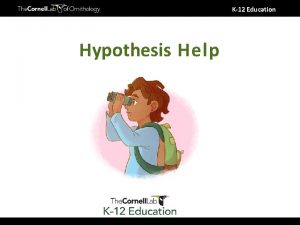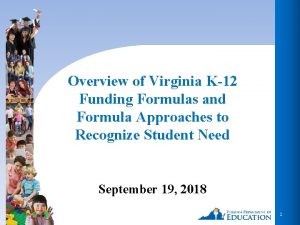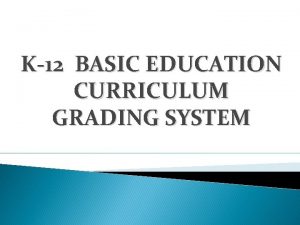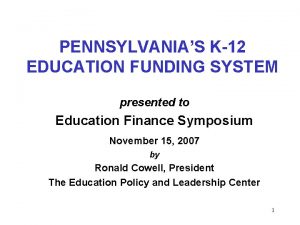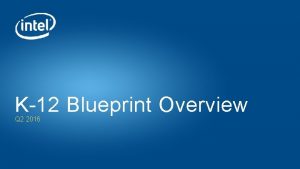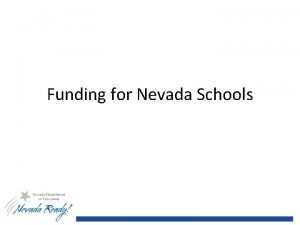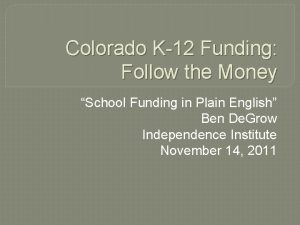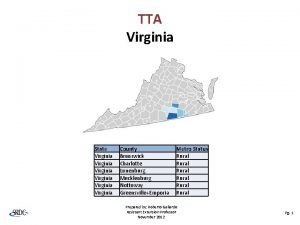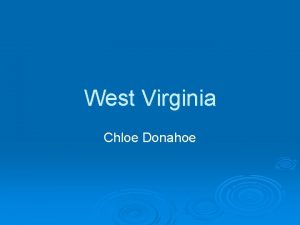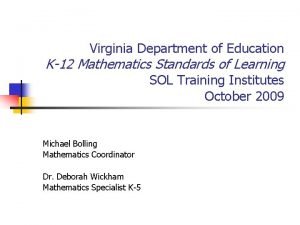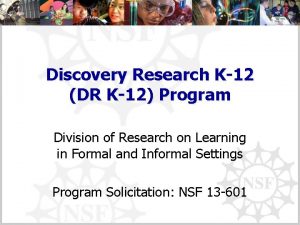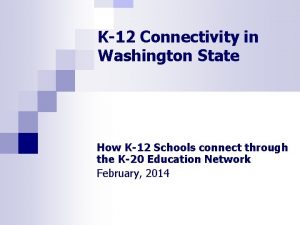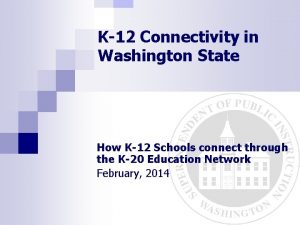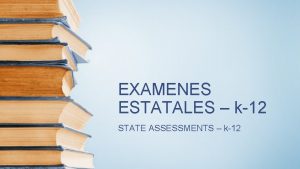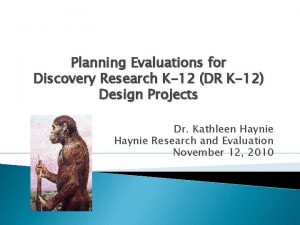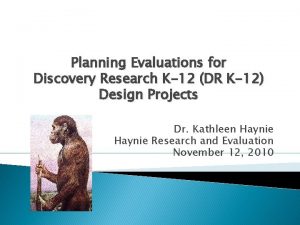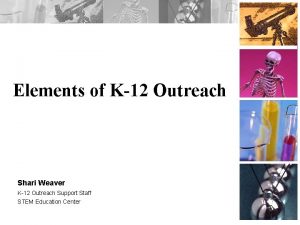Overview of K12 Education Funding in Virginia Direct


































- Slides: 34

Overview of K-12 Education Funding in Virginia (Direct Aid to Public Education Budget) Ed Lanza – Budget Director February 2018

Sources of Public Education Funding in Virginia - FY 2016 % of Funding for Operational Expenditures by Source Based on the 2015 -2016 Superintendent’s Annual Report - Table 15 (Does not include debt service or other capital expenses) Sales Tax 8. 8% FY 2016 Funding Sources: Local = $7, 782, 624, 245 State = $4, 876, 808, 079 Sales Tax = $1, 325, 354, 106 Federal = $1, 038, 140, 436 Total = $15, 022, 926, 866 Federal 6. 9% Local 51. 8% State 32. 5% 1

Direct Aid Budget § State and federal funding for public education is provided to school divisions through the Direct Aid to Public Education budget in the Appropriation Act. The General Assembly appropriates the funds; VDOE administers the funds. § Funding is appropriated in six budgetary categories, each containing multiple line-items: 1. Standards of Quality (SOQ) (majority of funding) 2. Incentive Programs 3. Categorical Programs 4. Lottery Proceeds Fund 5. Supplemental Education Programs 6. Federal Funds 2

FY 18 Direct Aid Appro. § The current Direct Aid appropriations for FY 18 by fund source (Chapter 836 budget) are: ü general funds (incl. 1. 125% of state sales tax) = $6. 03 billion ü trust and agency funds (includes Lottery and Literary Fund; Literary Fund is appropriated for VRS contributions) = $728. 2 million ü special funds = $3. 3 million ü federal funds = $887. 1 million ü total = $7. 65 billion § Historically, state funding for public education is about one-third (or less) of the state general fund budget. 3

Recent Per Pupil State Direct Aid Funding § Per pupil appropriated state funding (all sources; not inflation adjusted) in the Direct Aid budget for FY 2015 through FY 2018: ü FY 2015 = 4, 974 ü FY 2016 = 5, 179 ü FY 2017 = 5, 218 ü FY 2018 = 5, 414 4

SOQ Funding § The Constitution of Va. requires: ü the Board of Education to formulate Standards of Quality (SOQ) for public schools. ü the General Assembly to revise the SOQ, determine SOQ costs, and apportion the cost between the state and localities. ü The decision about how much to appropriate for public education is initiated by the Governor subject to final funding actions by the General Assembly. 5

SOQ Funding § SOQ is established in the Constitution of Va. as the minimum educational program school divisions must provide. § The specific program and staffing requirements are set out in the Code of Va. and the Appropriation Act. Most staffing standards are in Section 22. 1 -253. 13: 2 (Standard 2). § State funding must be matched by the locality. The minimum local funding required known as “required local effort. ” Amount determined by the Composite Index. 6

SOQ Funding § The main source of state funding for school divisions. § $5. 96 billion – or 88% of state funding for public education – in FY 18. Over 80% of SOQ formula funding is for salaries and benefits; the rest for non-personal costs (materials/supplies, utilities, etc. ). § Projected Required Local Effort for FY 18 is $3. 71 billion. (In FY 16, localities exceeded their required effort for the SOQ by 82. 95% overall. ) § SOQ funding based mostly on JLARC methodology from mid/late ‘ 80 s, with subsequent changes through the years. Last major SOQ funding initiative occurred at the 2004 Session; reductions made at 2009 and 2010 Sessions. 7

State Direct Aid Funding FY 2018 State Direct Aid Funding by Service Area (Based on Chapter 836 Budget) Categorical Programs 0. 9% Incentive Programs 2. 4% Lottery Proceeds Fund 8. 1% Supplemental Education 0. 4% Standards of Quality 88. 2% FY 2018 State Funding: SOQ = $5, 962, 735, 008 Incentive = $164, 957, 065 Categorical = $59, 102, 697 Lottery Proceeds Fund = $546, 495, 789 Supplemental Education = $28, 253, 945 Total = $6, 761, 544, 504 8

SOQ Funding § FY 18 funding for the SOQ is provided through the following accounts, mostly on a per pupil basis: – Basic Aid (incl. instructional and support pos. , nonpersonal support, & health care) – Special Education – Career and Technical Education – Prevention, Intervention, and Remediation – Gifted Education – English as a Second Language – Fringe Benefits for funded instructional positions (VRS, 9 – – – Soc. Sec. , Group Life) Sales Tax (1. 125% for public education) Textbooks Remedial Summer School Early Reading Intervention (from Lottery funds) SOL Algebra Readiness (from Lottery funds)

Determining SOQ Costs § Three components of SOQ cost are funded: 1. required number of instructional positions (based on staffing standards in Stnd. 2 of SOQ statute, Appro. Act, & BOE regs. , and the funded salaries & benefit rates applied to the positions); 2. recognized support positions (with funded salaries & benefit rates applied); and, 3. recognized non-personal support costs (e. g. , supplies/materials, utilities, etc. ). § The support cost components in 2. and 3. are funded through Basic Aid mostly on a “prevailing cost” basis using the “linear weighted average. ” Support positions “capped” based on a ratio of approx. 1 support position per 4 instructional positions. § Most funding for SOQ accounts provided on a per pupil basis through average daily membership (ADM); Sales Tax distributed based on estimated school-age population. 10

Prevailing Costs/Linear Wtg. Avg. § Where SOQ cost items have no established standard, “prevailing cost” from actual division expenditures used as the basis for funding. Intended to reflect what most divisions spend in the amount of SOQ funding provided. Used in determining SOQ funded salaries, non-personal support costs, and support staffing per pupil. § “Prevailing cost” calculated using the “linear weighted average, ” a weighted average giving greatest weight to costs closest to the median cost (up to a wtg. of 5), and least weight to costs closest to the highest and lowest outlying values (down to a wtg. of 1). 11

Prevailing Costs/Linear Wtg. Avg. § Divisions’ actual salaries, non-personal costs per pupil, and support staffing per pupil can be above or below the linear weighted average values used for SOQ funding. 12

Illustration of Wtgs. in Linear Wtg. Avg. 6 Weight Assigned to Data Values 5 5 4 4 3 3 2 2 2 1 1 0 1 2 3 4 5 6 7 Example Data Values Used in Linear Wtg. Avg. Calculation 13 8 9

Distribution of LWA Weights 14

Determining SOQ Costs § Input data used to cost out the three cost components updated every 2 years during biennial ”rebenchmarking” process that occurs in “odd” years for biennial budgets acted on at GA sessions in “even” years: 1. base year number of students – all; spec. ed; CTE; 2. staffing standards for teachers and other instructional positions; 3. salaries of teachers and other instructional positions; 4. fringe benefit rates; 5. standard and prevailing support costs; 6. inflation factors; 7. federal revenues deducted from support costs; 8. amount of sales tax revenue and school division composite indices. 15

Determining SOQ Costs 16

Determining SOQ Costs State and Local Shares of Total Basic Aid Cost (Sales Tax reduces the total cost of Basic Aid) Sales Tax distributed on the basis of School Age Population Total Basic Aid Cost = Basic Aid Per Pupil Amount x Average Daily Membership Balance of Basic Aid split into state and local shares based on the Composite Index Average Local Share = 45% Average State Share = 55% Note: State and local shares will vary by locality based on each locality's composite index. 17

Other SOQ Formula Concepts § SOQ establishes minimum requirements but doesn’t restrict localities/divisions from spending more than their required amount to offer programs and employ staff beyond SOQ requirements. § Not a dollar-for-dollar reimbursement of actual division expenditures; funds specific standards and recognized costs - divisions’ salaries, staffing levels, and other costs may be higher than those provided through the SOQ formulas. § Does not provide full state funding but a state share of formula costs based on the Composite Index. § Funds limited capital expenditures. Does not fund certain costs or programs such as debt service, school meal programs, regular summer school, or preschool. 18

Past SOQ Reductions § Reductions to the SOQ funding formula enacted mostly at the 2009 & 2010 Sessions in response to state budget shortfalls: ü “capped” support positions by applying instruction to support position ratio; ü eliminated inflationary funding for non-personal costs (funded for 2016 -2018); ü removed various non-personal funding items; ü reduced prevailing cost averages; ü health care funding adjusted for local participation; ü extended bus replacement cycle from 12 to 15 years; ü increased federal revenue deduction; and, ü eliminated Cost of Competing funding for SOQ support positions (partially funded for 2016 -2018). 19

State-Local Shares of Cost § General Assembly responsible for “apportioning” the cost of SOQ programs between the state and localities. § Most state funding for school divisions is “equalized” or adjusted for local ability to pay education costs. § Local ability to pay is determined by the “Composite Index of Local Ability-to-pay” formula. § The Composite Index is used to determine each division’s state and local shares of cost for the Standards of Quality (SOQ) and other applicable Direct Aid programs. 20

Composite Index Formula § The General Assembly establishes the Composite Index formula in the Appropriation Act. § The formula uses three indicators to estimate "ability-to-pay" for each locality: ü True Value of Real Property in the locality (weighted 50%) ü Va. Adjusted Gross Income in the locality (weighted 40%) ü Taxable Retail Sales in the locality (weighted 10%) § To account for varying sizes of localities, each indicator is expressed on a per capita basis (using local population & weighted 33%) and on a per pupil basis (using student enrollment & weighted 67%). § The index value for each locality is the local per capita/per pupil values in the formula as a proportion of the corresponding statewide average values. 21

Composite Index Formula (ADM = average daily membership) 22

Composite Index Formula § Each index is adjusted so that the statewide average local share is 45 percent and the statewide average state share is 55 percent. § The formula is recomputed each biennium using the most recent data available – the indices for 2016 -2018 are based on 2013 data. § The index value represents the local share of costs (inverse is state share) – for example, an index of 0. 7500 = 75% local share / 25% state share of SOQ formula costs. § The maximum index is capped at 0. 8000 – the range of index values for 2016 -2018 is 0. 1701 to 0. 8000. 23

Composite Index Formula § Past legislative commissions/proposals have looked at incorporating factors such as “fiscal stress, ” “fiscal effort, ” or “land use” into the formula to better reflect local ability to pay. § Due to nature of the formula, any change creates funding “winners” and “losers” based on how the change impacts the calculation of each division’s index. § Student or community poverty measures not directly incorporated into the formula, but free lunch eligibility is used in the SOQ remediation formula and formulas for several other Direct Aid accounts. 24

Other State Funding: Incentive Programs § Provides $165. 0 million in FY 18 for optional programs beyond the SOQ (2. 4% of total state funding). § Incentive programs are voluntary programs, but in order to receive state funds, school divisions must agree to meet additional requirements, such as: ü certifying they will offer the specific program ü meeting requirements established for the program and provide local match, if one is required § Example programs: Compensation Supplement, Governor’s Schools, Math/Reading Instructional Specialists Initiative, Breakfast After the Bell Incentive. 25

Categorical Programs § Provides $59. 1 million in FY 18 for programs beyond the SOQ (0. 9% of total state funding). § State or federal statutes or regulations mandate much of this funding. § Programs are usually targeted to the particular needs of specific student populations. § Example programs: Adult education/literacy, Virtual Virginia, required spec. ed. services, and the school lunch program state match. 26

Lottery Funds § Lottery funds are designated for 17 programs in FY 18, including two SOQ accounts (i. e. , Early Reading Intervention & SOL Algebra Readiness). Lottery proceeds must be appropriated for public education and paid to localities. § Several Incentive and Categorical accounts were moved to Lottery funds from the general fund by the 2008 GA. § Some of the formulas use Free Lunch Eligibility as a proxy for students at-risk. Most programs have a required local match to receive the state funds. § Provides $546. 5 million in FY 18 (8. 1% of total state funding). Example programs: Va. Preschool Initiative, Early Reading Intervention, K-3 Class Size Reduction. 27

Lottery Funds § 2016 General Assembly funded a “Supplemental Lottery Per Pupil Allocation, ” reinstating a per pupil funding mechanism that was suspended during the recession. § Funding level in Chapter 836 budget is $36. 6 M for FY 17 and $191. 3 M for FY 18. § No local match required to receive the funds and the Chp. 836 budget provides flexibility to use the funds on either capital or non-capital purposes. 28

Supplemental Education Programs § Provides $28. 3 million in FY 18 (0. 4% of total state funding). § Funded through 31 line-items and directed to specific regional, school division, or organizational recipients for programmatic purposes designated in the Act; not available to divisions statewide. § Example programs: Virginia Teaching Scholarship Loan Program and National Board Certification teacher bonuses. 29

Federal Funds § Federal funding derived mostly from five separate federal programs: ü Elementary & Secondary Education Act (“Every Student Succeeds Act” or ESSA) - targets funding to disadvantaged students & challenged schools to meet state achievement standards. ü Individuals with Disabilities Education Act - funding for students with disabilities. ü Carl Perkins Act - funding for career & technical education programs. ü Adult Ed. & Family Literacy Act - funding for adult education programs. ü Healthy, Hunger-Free Kids Act (USDA) - provides subsidies for school meal programs, including free & reduced-priced meals for eligible students; supports increased nutrition standards for school meals. § Funds allocated to divisions by formula and paid to them on a reimbursement basis through DOE’s online reimbursement system (OMEGA); school divisions reimbursed approx. one billion per year. 30

Future Direct Aid Funding Cost Drivers § Several factors may contribute to increased state costs of SOQ and other Direct Aid programs in future biennia: ü continued student enrollment increases and increased division spending picked-up in prevailing costs; ü complete phase-in of 100% of actuarial VRS rate in FY 18 and if policy maintained going forward; ü continuation cost of future teacher salary increases reflected in the funded salary amount for subsequent biennia; ü likely increase in funded health care premium; ü likely increase in English Language Learner population and student free lunch eligibility; and, ü higher SOL failure rates for some divisions used in SOQ Remediation formula. 31

2018 -2020 “Rebenchmarking” Process and Gov’s. Budget § The technical Direct Aid “rebenchmarking” process (updates to formulas) by DOE for the 2018 -2020 budget occurred Spring 2017 -Fall 2017. § Final Direct Aid rebenchmarking costs included in the Gov’s. 18 -20 introduced budget to 2018 GA were $232. 8 million in FY 19 and $254. 7 million in FY 20. § Introduced budget also included several new initiatives proposed by the Gov. to 2018 GA, such as: FY 20 teacher salary increase ($51. 3 M); FY 19 No Loss payment to certain divisions ($11. 5 M); one principal per elem. school beginning FY 20 ($7. 7 M); additional At-risk Add-on funding beginning FY 20 ($7. 1 M). 32

DOE Website Resources • “School Finance” Web page: http: //www. doe. virginia. gov/school_finance /index. shtml • “Budget & Grants Management” Web page: http: //www. doe. virginia. gov/school_finance /budget/index. shtml Ø Links to school division funding allocations (downloadable Excel files), Composite Index data, and other information. 33
 Marcus scheuren
Marcus scheuren Northern virginia seo audit
Northern virginia seo audit Ic.wpcsd.k12.ny
Ic.wpcsd.k12.ny K12
K12 School vouchers pros and cons
School vouchers pros and cons K12cart login
K12cart login K12
K12 Yahya kemal beyatlı anadolu lisesi batman
Yahya kemal beyatlı anadolu lisesi batman Ero henrico k12 va us
Ero henrico k12 va us Visitor checkin system
Visitor checkin system Aleks k12
Aleks k12 K12 curriculum
K12 curriculum K12
K12 Timekeeper.cabarrus.k12.nc.us
Timekeeper.cabarrus.k12.nc.us Totalview school k12
Totalview school k12 Pine view middle school florida
Pine view middle school florida Powerschool.tattnall.k12
Powerschool.tattnall.k12 Pam program
Pam program Borderless classroom extension
Borderless classroom extension Nutrition jeopardy
Nutrition jeopardy Strand shs
Strand shs Linux terminal server einrichten
Linux terminal server einrichten K12 system
K12 system Florida technology integration matrix
Florida technology integration matrix Speiseplan k12
Speiseplan k12 Ohio means jobs k-12
Ohio means jobs k-12 Overview of education in health care
Overview of education in health care Drivers ed module 10 topic 1
Drivers ed module 10 topic 1 Module 7 topic 5-6 drivers ed
Module 7 topic 5-6 drivers ed Module 11 drivers ed virginia
Module 11 drivers ed virginia Module 8 topic 1 drivers ed
Module 8 topic 1 drivers ed Module 3 topic 2 vision and driving
Module 3 topic 2 vision and driving Lane position 1-4
Lane position 1-4 S.e.e.i.t method driving
S.e.e.i.t method driving Module 8 topic 1
Module 8 topic 1



